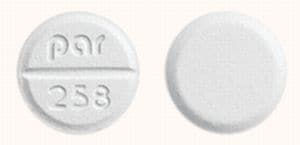Dosage Forms
Excipient information presented when available (limited, particularly for generics); consult specific product labeling. [DSC] = Discontinued product
Syrup, Oral, as sulfate:
Generic: 10 mg/5 mL (473 mL)
Tablet, Oral, as sulfate:
Generic: 10 mg [DSC], 20 mg [DSC]
Pharmacology
Mechanism of Action
Stimulates beta2-receptors which increases the conversion of adenosine triphosphate (ATP) to 3’-5’-cyclic adenosine monophosphate (cAMP), resulting in bronchial smooth muscle relaxation
Pharmacokinetics/Pharmacodynamics
Absorption
Oral: Well absorbed
Metabolism
Extensive first-pass in the liver (~40% of oral dose is available)
Excretion
Mainly as glucuronic acid conjugates
Onset of Action
Bronchodilation: Oral: ~30 minutes; Peak effect: Oral: ~1 hour
Duration of Action
~2 to 6 hours, regardless of route administered
Use: Labeled Indications
Asthma/Bronchospasm: Bronchial asthma and for reversible bronchospasm which may occur in association with bronchitis and emphysema.
Contraindications
Hypersensitivity to metaproterenol or any component of the formulation; pre-existing cardiac arrhythmias associated with tachycardia
Documentation of allergenic cross-reactivity for sympathomimetics is limited. However, because of similarities in chemical structure and/or pharmacologic actions, the possibility of cross-sensitivity can not be ruled out with certainty.
Dosage and Administration
Dosing: Adult
Asthma/Bronchospasm: Oral: 20 mg 3 or 4 times daily Note: Oral bronchodilators are not recommended for routine use in the management of acute asthma or long-term daily maintenance treatment due to a slower onset of action and higher risk of side effects compared to inhaled short acting beta agonists (GINA 2018; NAEPP 2007).
Dosing: Geriatric
Refer to adult dosing.
Dosing: Pediatric
Note: Oral bronchodilators are not recommended for routine use in the management of acute asthma or long-term daily maintenance treatment due to a slower onset of action and higher risk of side effects compared to inhaled short acting beta agonists (GINA 2017; NAEPP 2007).
Asthma/bronchospasm: Children and Adolescents:
Children ≤5 years: Oral: 1.3 to 2.6 mg/kg/day divided every 6 to 8 hours; maximum dose: 10 mg/dose (Nelson 1996)
Children 6 to 9 years or weighing <27 kg: Oral: 10 mg 3 to 4 times daily
Children >9 years and Adolescents or weighing ≥27 kg: Oral: 20 mg 3 to 4 times daily
Administration
Administer without regards to food. May administer with food if GI upset occurs.
Storage
Store at room temperature; protect from light. Protect tablets from moisture.
Metaproterenol Images
Drug Interactions
AtoMOXetine: May enhance the tachycardic effect of Beta2-Agonists. Monitor therapy
AtoMOXetine: May enhance the hypertensive effect of Sympathomimetics. AtoMOXetine may enhance the tachycardic effect of Sympathomimetics. Monitor therapy
Atosiban: Beta2-Agonists may enhance the adverse/toxic effect of Atosiban. Specifically, there may be an increased risk for pulmonary edema and/or dyspnea. Monitor therapy
Beta-Blockers (Beta1 Selective): May diminish the bronchodilatory effect of Beta2-Agonists. Of particular concern with nonselective beta-blockers or higher doses of the beta1 selective beta-blockers. Monitor therapy
Beta-Blockers (Nonselective): May diminish the bronchodilatory effect of Beta2-Agonists. Avoid combination
Betahistine: May diminish the therapeutic effect of Beta2-Agonists. Monitor therapy
Cannabinoid-Containing Products: May enhance the tachycardic effect of Sympathomimetics. Exceptions: Cannabidiol. Monitor therapy
Cocaine (Topical): May enhance the hypertensive effect of Sympathomimetics. Management: Consider alternatives to use of this combination when possible. Monitor closely for substantially increased blood pressure or heart rate and for any evidence of myocardial ischemia with concurrent use. Consider therapy modification
Doxofylline: Sympathomimetics may enhance the adverse/toxic effect of Doxofylline. Monitor therapy
Guanethidine: May enhance the arrhythmogenic effect of Sympathomimetics. Guanethidine may enhance the hypertensive effect of Sympathomimetics. Monitor therapy
Linezolid: May enhance the hypertensive effect of Sympathomimetics. Management: Reduce initial doses of sympathomimetic agents, and closely monitor for enhanced pressor response, in patients receiving linezolid. Specific dose adjustment recommendations are not presently available. Consider therapy modification
Loop Diuretics: Beta2-Agonists may enhance the hypokalemic effect of Loop Diuretics. Monitor therapy
Loxapine: Agents to Treat Airway Disease may enhance the adverse/toxic effect of Loxapine. More specifically, the use of Agents to Treat Airway Disease is likely a marker of patients who are likely at a greater risk for experiencing significant bronchospasm from use of inhaled loxapine. Management: This is specific to the Adasuve brand of loxapine, which is an inhaled formulation. This does not apply to non-inhaled formulations of loxapine. Avoid combination
Methacholine: Beta2-Agonists (Short-Acting) may diminish the therapeutic effect of Methacholine. Management: Hold short-acting beta2 agonists for 6 hours before methacholine use. Consider therapy modification
Monoamine Oxidase Inhibitors: May enhance the adverse/toxic effect of Beta2-Agonists. Monitor therapy
Solriamfetol: Sympathomimetics may enhance the hypertensive effect of Solriamfetol. Monitor therapy
Sympathomimetics: May enhance the adverse/toxic effect of other Sympathomimetics. Monitor therapy
Tedizolid: May enhance the hypertensive effect of Sympathomimetics. Tedizolid may enhance the tachycardic effect of Sympathomimetics. Monitor therapy
Thiazide and Thiazide-Like Diuretics: Beta2-Agonists may enhance the hypokalemic effect of Thiazide and Thiazide-Like Diuretics. Monitor therapy
Tricyclic Antidepressants: May enhance the adverse/toxic effect of Beta2-Agonists. Monitor therapy
Adverse Reactions
>10%:
Cardiovascular: Tachycardia (6% to 17%)
Central nervous system: Nervousness (5% to 20%)
Neuromuscular & skeletal: Tremor (2% to 17%)
1% to 10%:
Cardiovascular: Palpitations (4%)
Central nervous system: Headache (1% to 7%), dizziness (2%), insomnia (2%), fatigue (1%)
Gastrointestinal: Nausea (1% to 4%), diarrhea (1%)
Respiratory: Exacerbation of asthma (2%)
<1%, postmarketing, and/or case reports: Blurred vision, change in appetite, chest pain, chills, clonus, cough, diaphoresis, drowsiness, dry throat, edema, facial edema, fever, flu-like symptoms, hypertension, muscle spasm, pain, pruritus, sensory disturbance, swelling of fingers, syncope, unpleasant taste, urticaria, vomiting, weakness, xerostomia
Warnings/Precautions
Concerns related to adverse effects:
- Hypersensitivity reactions: Immediate hypersensitivity reactions (urticaria, angioedema, rash, bronchospasm) have been reported.
Disease-related concerns:
- Asthma: Appropriate use: Metaproterenol (a less selective beta2-agonist) is not recommended in the management of asthma due to potential for excessive cardiac stimulation (NAEPP, 2007). Oral systemic agents (eg, tablets, syrup) should be avoided due to increased risk of adverse effects (eg, excessive cardiac stimulation).
- Cardiovascular disease: Use with caution in patients with cardiovascular disease (arrhythmia or hypertension or HF); beta-agonists may cause elevation in blood pressure, heart rate and result in CNS stimulation/excitation. Beta2-agonists may also increase risk of arrhythmias.
- Chronic obstructive lung disease (COPD): Appropriate use: Inhaled bronchodilators are preferred therapy for COPD exacerbations; oral systemic agents (eg, tablets, syrup) should be avoided due to increased risk of adverse effects (eg, excessive cardiac stimulation).
- Diabetes: Use with caution in patients with diabetes mellitus; beta2-agonists may increase serum glucose.
- Glaucoma: Use with caution in patients with glaucoma; beta2-agonists may elevate intraocular pressure.
- Hyperthyroidism: Use with caution in hyperthyroidism; beta2-agonists may stimulate thyroid activity.
- Hypokalemia: Use with caution in patients with hypokalemia; beta2-agonists may decrease serum potassium.
- Seizures: Use with caution in patients with seizure disorders; beta-agonists may result in CNS stimulation/excitation.
Dosage form specific issues:
- Benzyl alcohol and derivatives: Some dosage forms may contain sodium benzoate/benzoic acid; benzoic acid (benzoate) is a metabolite of benzyl alcohol; large amounts of benzyl alcohol (≥99 mg/kg/day) have been associated with a potentially fatal toxicity (“gasping syndrome”) in neonates; the “gasping syndrome” consists of metabolic acidosis, respiratory distress, gasping respirations, CNS dysfunction (including convulsions, intracranial hemorrhage), hypotension, and cardiovascular collapse (AAP ["Inactive" 1997]; CDC 1982); some data suggests that benzoate displaces bilirubin from protein binding sites (Ahlfors 2001); avoid or use dosage forms containing benzyl alcohol derivative with caution in neonates. See manufacturer's labeling.
Monitoring Parameters
Heart rate, and blood pressure; FEV1, peak flow, and/or other pulmonary function tests; CNS stimulation; serum glucose, serum potassium (in selected patients)
Pregnancy
Pregnancy Risk Factor
C
Pregnancy Considerations
Adverse events were observed in some animal reproduction studies. Beta agonists, including metaproterenol, may interfere with uterine contractility if administered during labor; maternal and fetal tachycardia have been observed (Baillie 1970; Tyack 1971).
Uncontrolled asthma is associated with adverse events on pregnancy (increased risk of perinatal mortality, pre-eclampsia, preterm birth, low birth weight infants). Oral beta2-receptor agonists are not recommended to treat asthma during pregnancy (NAEPP 2005).
Patient Education
- Discuss specific use of drug and side effects with patient as it relates to treatment. (HCAHPS: During this hospital stay, were you given any medicine that you had not taken before? Before giving you any new medicine, how often did hospital staff tell you what the medicine was for? How often did hospital staff describe possible side effects in a way you could understand?)
- Patient may experience anxiety. Have patient report immediately to prescriber severe headache, vision changes, fast heartbeat, abnormal heartbeat, severe dizziness, passing out, or tremors (HCAHPS).
- Educate patient about signs of a significant reaction (eg, wheezing; chest tightness; fever; itching; bad cough; blue skin color; seizures; or swelling of face, lips, tongue, or throat). Note: This is not a comprehensive list of all side effects. Patient should consult prescriber for additional questions.
Intended Use and Disclaimer: Should not be printed and given to patients. This information is intended to serve as a concise initial reference for healthcare professionals to use when discussing medications with a patient. You must ultimately rely on your own discretion, experience and judgment in diagnosing, treating and advising patients.




